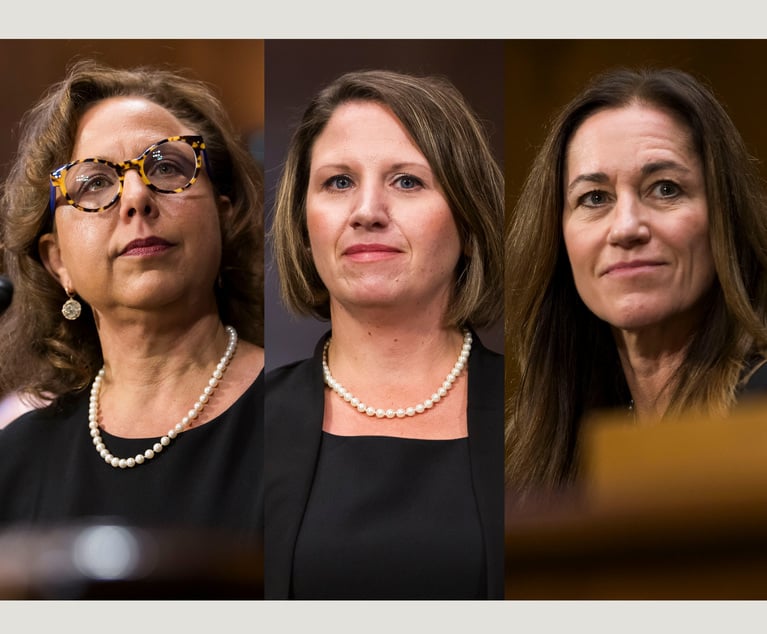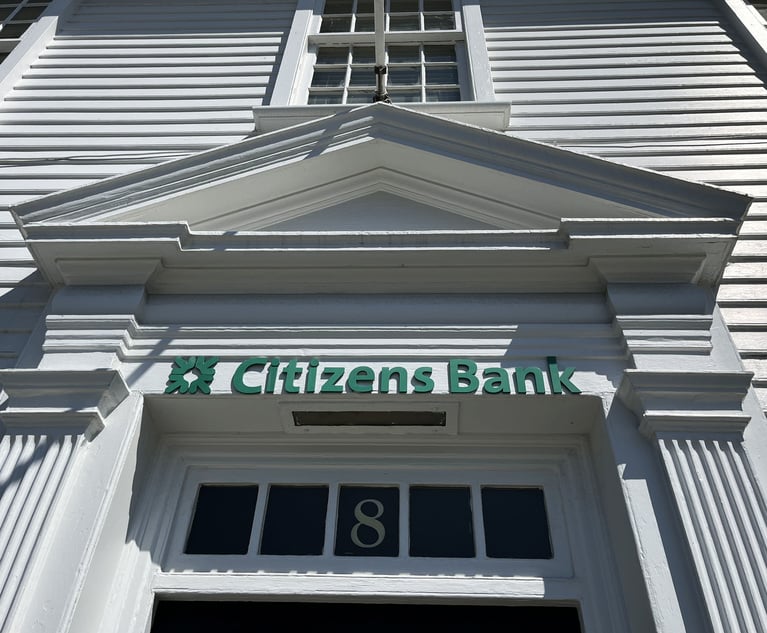The Coast Is Not Always Clear: Mixing Trademarks for Wine, Liquor and Beer
The popularity of craft breweries and distilleries has grown at exponential rates in the past few years. There are now over 1,800 craft distilleries in the United States, up from roughly 100 in 2005 and 7,400 craft distilleries up from approximately 1,400 in 2005.
February 18, 2020 at 03:45 PM
7 minute read
 John O'Malley and Laura S. Lipschutz of Volpe and Koenig
John O'Malley and Laura S. Lipschutz of Volpe and Koenig
The popularity of craft breweries and distilleries has grown at exponential rates in the past few years. There are now over 1,800 craft distilleries in the United States, up from roughly 100 in 2005 and 7,400 craft distilleries up from approximately 1,400 in 2005. These increases are reflected in Pennsylvania where the number of distilleries has gone from single digits in 2011 to over 80 in 2019. Similar growth is occurring internationally and in related sectors such as craft hard cider and seltzer.
With this growth there has also been a rise in trademark filings with the U.S. Patent and Trademark Office (USPTO) in all alcohol-related sectors. Likewise, many beer, wine, cider or spirit companies that have traditionally occupied only one of the alcoholic beverage sectors are now expanding into the others. This boom in craft alcohol production popularity coupled with the emerging cross-production of beer, wine and spirits has blurred the branding lines, creating more confusion between brands and increased the difficulty in obtaining IP protection. This article focuses on the new crowded and intertwined alcohol space, and its effect on branding and trademarks.
Federal Trademark registration with the USPTO is unarguably one of the most important branding aspects for any business, big or small because of the many advantages it affords, including:
- Right to use the registered trademark symbol;
- Legal advantages
- Constructive notice of registrant's ownership;
- Nationwide priority from application filing date;
- Legal presumption of ownership.
- Generally necessary for online, domain name, social media and app store enforcement.
As background, in order to obtain a trademark registration, one must file an application in the USPTO where the mark will be examined to determine the applied-for trademark's "registrability." The USPTO considers many factors when determining whether an applied for trademark is worthy of federal protection. One of the most important concerns is whether the mark, if registered, would create a likelihood of confusion with a prior registered mark. The USPTO will evaluate a number of factors to determine whether marks are confusingly similar, but the two most important factors are whether the marks the look and sound similar, and whether the goods and services provided under the marks are related. In order to establish a likelihood of confusion, goods and services need not be identical, only related.
Though each trademark case is fact intensive and decided on its own merits, historically, the USPTO's Trademark Trial and Appeal Board (TTAB) did not consider beer, wine and liquor to be per se related. Meaning that some similar alcohol related marks could coexist if the products sold under the similar marks were not in the same category of alcoholic beverages.
Two cases from 2014 and 2015 show this delineation. In re Congregation Ale House (AZUSA Chapter), (TTAB Sept. 9, 2014) (reasoning that beer and wine are "somewhat related," but that the evidence presented did not "indicate whether they may emanate from a single source"); In re S.P.H.-Gerard Bertrand, 2015 TTAB LEXIS 544, at *5 (TTAB Sept. 28, 2015) (admitting that "there is some degree of relationship between beer and wine" but that "it is not strong.").
In just a few short years since these cases, the USPTO has somewhat changed its tune. Recently, alcoholic beverage companies have begun cross-producing new alcoholic beverages, expanding into other markets. For example, Budweiser famously introduced its "Lime-A-Rita" malt liquor beverages in 2012 and has recently introduced a line of hard seltzers. Beer drinkers and hard seltzer drinkers may overlap somewhat, but it is clear that Budweiser is attempting to expand its customer base with these new products.
With the rise in distilleries and the new trend in alcohol cross-production, it can be argued that the consuming public may recognize brands as the source of wine, beer and liquor despite whether the brand actually has expanded into each of the categories. Recognizing this and following market trends, the USPTO has shifted its previous delineation between wine, beer and liquor and now increasingly considers alcohol products to be related. Although there is no bright line rule that alcoholic beverages are related, now more than ever, the USPTO and TTAB are refusing to register similar marks when used in connection with varying alcoholic beverages (e.g., beer and wine) citing that a likelihood of confusion will arise in the eyes of the consuming public.
For example, in 2018, the TTAB refused registration for the mark VOLKS PILS for beer and lager for being confusingly similar to the prior registered mark VOLK for vodka. In re Marshall Brewing, (TTAB Apr. 9, 2018) In re Marshall Brewing, Serial No. 87019347 (April 9, 2018). Evidence in the record included articles that discussed breweries expanding into distilling spirits; even so, the Board reasoned that goods can be related even if there is no evidence that any entity is the source of both goods at issue. In this case, however, the evidence showed that at least some entities were the source of both beer and vodka thus making them related.
In a similar TTAB decision, the board refused registration for the mark Dead Bird Brewing Co. for beer because it was confusingly similar to Dead Bird for wine. The board reasoned that "while consumers may be aware of coexisting marks, this does not negate that they may also be aware for the same mark being used in connection with beer and wine by the same entity," see (In re Dead Bird Brewing, (TTAB June 13, 2018).
In September 2019, the board took the analysis one step further by finding an intricate design mark that included Mystic Mountain Outlaw Whiskey with a skull and two guns design for whiskey only, to be confusingly similar to the registered mark Outlaw for alcoholic beverages. It reasoned that the design reinforced the term Outlaw, the presence of a house mark in this case did not distinguish similar products, and the additional terms in applicant's mark did not suffice to avoid confusion.
In a similar vein, the USPTO has found alcoholic and nonalcoholic beverages to be related. In one case, an opposition was upheld against a trademark application for Gott Light and Design for water, among other things, filed by the owners of registration s for Gott and Joel Gott for use with wines, see Joel Gott Wines v. Rehoboth Von Gott, (TTAB June 26, 2013). In refusing to register the marks, the USPTO found that water and wine can be sold in the same area of a store, and that the two are frequently combined to make popular drinks.
The rise in popularity of craft breweries, wineries and distilleries coupled with the new trend in cross-production and the perceived convergence of different sectors has made selecting and clearing a strong trademark for use and registration more difficult. At the same time an increasingly crowded market reinforces the need to have a strong trademark to differentiate one's brand from competitors and to influence consumers to purchase the product. Labeling, bottle design, branding and marketing are costly, and a trademark dispute can place those investments at risk and take the focus away from building the business.
In order to avoid or reduce these risks, those looking to enter or expand into the craft alcohol space should take note and adopt comprehensive branding strategies before choosing to label and market a particular name, which includes clearing a trademark through a trademark search process and seeking trademark registration protection.
John O'Malley, a shareholder with Volpe and Koenig, focuses his practice on advising clients on strategies for building brands and developing and protecting U.S. and international trademark portfolios. He also conducts IP audits and IP due diligence for banks, IP investment companies, venture capital and private equity investors. Contact him at [email protected].
Laura S. Lipschutz, an associate at the firm, and serves corporate clients as well as entrepreneurs, artists, and start-up clients in a wide variety of intellectual property matters. Contact her at [email protected].
This content has been archived. It is available through our partners, LexisNexis® and Bloomberg Law.
To view this content, please continue to their sites.
Not a Lexis Subscriber?
Subscribe Now
Not a Bloomberg Law Subscriber?
Subscribe Now
NOT FOR REPRINT
© 2025 ALM Global, LLC, All Rights Reserved. Request academic re-use from www.copyright.com. All other uses, submit a request to [email protected]. For more information visit Asset & Logo Licensing.
You Might Like
View All
Pa. Federal District Courts Reach Full Complement Following Latest Confirmation

The Defense Bar Is Feeling the Strain: Busy Med Mal Trial Schedules Might Be Phila.'s 'New Normal'
7 minute read
Federal Judge Allows Elderly Woman's Consumer Protection Suit to Proceed Against Citizens Bank
5 minute read
Judge Leaves Statute of Limitations Question in Injury Crash Suit for a Jury
4 minute readLaw Firms Mentioned
Trending Stories
- 1Gunderson Dettmer Opens Atlanta Office With 3 Partners From Morris Manning
- 2Decision of the Day: Court Holds Accident with Post Driver Was 'Bizarre Occurrence,' Dismisses Action Brought Under Labor Law §240
- 3Judge Recommends Disbarment for Attorney Who Plotted to Hack Judge's Email, Phone
- 4Two Wilkinson Stekloff Associates Among Victims of DC Plane Crash
- 5Two More Victims Alleged in New Sean Combs Sex Trafficking Indictment
Who Got The Work
J. Brugh Lower of Gibbons has entered an appearance for industrial equipment supplier Devco Corporation in a pending trademark infringement lawsuit. The suit, accusing the defendant of selling knock-off Graco products, was filed Dec. 18 in New Jersey District Court by Rivkin Radler on behalf of Graco Inc. and Graco Minnesota. The case, assigned to U.S. District Judge Zahid N. Quraishi, is 3:24-cv-11294, Graco Inc. et al v. Devco Corporation.
Who Got The Work
Rebecca Maller-Stein and Kent A. Yalowitz of Arnold & Porter Kaye Scholer have entered their appearances for Hanaco Venture Capital and its executives, Lior Prosor and David Frankel, in a pending securities lawsuit. The action, filed on Dec. 24 in New York Southern District Court by Zell, Aron & Co. on behalf of Goldeneye Advisors, accuses the defendants of negligently and fraudulently managing the plaintiff's $1 million investment. The case, assigned to U.S. District Judge Vernon S. Broderick, is 1:24-cv-09918, Goldeneye Advisors, LLC v. Hanaco Venture Capital, Ltd. et al.
Who Got The Work
Attorneys from A&O Shearman has stepped in as defense counsel for Toronto-Dominion Bank and other defendants in a pending securities class action. The suit, filed Dec. 11 in New York Southern District Court by Bleichmar Fonti & Auld, accuses the defendants of concealing the bank's 'pervasive' deficiencies in regards to its compliance with the Bank Secrecy Act and the quality of its anti-money laundering controls. The case, assigned to U.S. District Judge Arun Subramanian, is 1:24-cv-09445, Gonzalez v. The Toronto-Dominion Bank et al.
Who Got The Work
Crown Castle International, a Pennsylvania company providing shared communications infrastructure, has turned to Luke D. Wolf of Gordon Rees Scully Mansukhani to fend off a pending breach-of-contract lawsuit. The court action, filed Nov. 25 in Michigan Eastern District Court by Hooper Hathaway PC on behalf of The Town Residences LLC, accuses Crown Castle of failing to transfer approximately $30,000 in utility payments from T-Mobile in breach of a roof-top lease and assignment agreement. The case, assigned to U.S. District Judge Susan K. Declercq, is 2:24-cv-13131, The Town Residences LLC v. T-Mobile US, Inc. et al.
Who Got The Work
Wilfred P. Coronato and Daniel M. Schwartz of McCarter & English have stepped in as defense counsel to Electrolux Home Products Inc. in a pending product liability lawsuit. The court action, filed Nov. 26 in New York Eastern District Court by Poulos Lopiccolo PC and Nagel Rice LLP on behalf of David Stern, alleges that the defendant's refrigerators’ drawers and shelving repeatedly break and fall apart within months after purchase. The case, assigned to U.S. District Judge Joan M. Azrack, is 2:24-cv-08204, Stern v. Electrolux Home Products, Inc.
Featured Firms
Law Offices of Gary Martin Hays & Associates, P.C.
(470) 294-1674
Law Offices of Mark E. Salomone
(857) 444-6468
Smith & Hassler
(713) 739-1250





